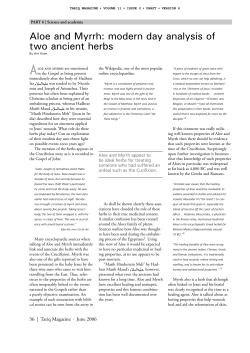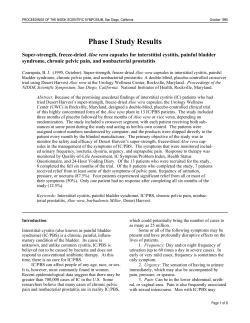
B O T A N I C A L
CAL CONSER VA TO R I V V UN IS B NI Y O TA ER SI TY OF CALIFOR volume 1, issue 1.0 NI A D A university of california davis botanical conservatory July, 2009 The Genus Aloe Aloe has a long ethnobotanical and medicinal history around world. Here we will look at aloe from both a botanical and horticultural viewpoint, and also take a brief look at the facts and the myths surrounding its medical uses. Aloe vera is is a commonly known plant, but it is only one of about 400 species in the genus Aloe. All aloes have rosettes of fleshy leaves, which may be spined or smooth. The majority of aloes have spines of various rigidity along the edges of their succulent leaves. The flowers are tubular shaped, and come in colors ranging from nearwhite to yellow to orange to near-red. The flowers are held high on single or branched stalks, and the resulting seeds are held in dry capsules. Pollination of aloes in their native range of Africa and adjoining areas is done by non-hovering birds. As a result of this coevolution, there is always a rigid stalk for the birds to take hold of while they probe flowers for nectar. The range of sizes among the species varies greatly, from small grass-like aloes such as A. descoingsii, whose rosettes can be less than an inch wide, to large tree aloes that can grow to be 50 such as A. bainesii. They may be ground hugging and referred to as stemless or form stems which may be single, treelike, or branched, shrub-like. Most stand perfectly upright while a few creep along the ground. Even though they are now grown around The distribution of the genus the world for their Aloe is shown in orange. beautiful forms, flowers, and medicinal properties, aloes originated around the African continent. They are native to sub-Saharan Africa, the Saudi Arabian Peninsula, and to many islands of the western Indian Ocean, including Madagascar. The center of diversity for aloes is South Africa, which hosts more than 120 species and has a rich heratige the plants. One of the most beautiful and collectable of all aloes is Aloe polyphylla, seen here growing at Hortus Botanicus Nursery near Fort Bragg, Calif. • botanical notes • Aloes are often thought to only grow in hot and dry climates but they actually grow in a variety of climates including desert, grassland, and coastal or even alpine locations. One of the most beautiful of all aloes, A. polyphylla, can be found as high as 11,500 feet above sea level in the Drakensberg mountains of Lesotho. In most cases aloes are found growing in rocky or gravelly soils, but they will also grow in richer soils among grasses, out of cracks and crevasses in rocks, or in sand. Aloes usually grow in the open and won’t normally be found among shrubs or trees unless the sun is very intense, where they use other plants for protection. Most often, populations of aloe will be sparse, although sometimes they are the dominant species in an area. In Africa, aloes are pollinated by sunbirds, whose long beaks and tongues are well suited to extract the nectar from the flowers. In the Americas, hummingbirds pollinate our garden aloes! Aloes have recently been placed in the family Asphodelaceae after years of being considered part of the lily family (Liliaceae). Although still related to the lily, aloes and other plants now in the Asphodelaceae family have been found to have significant morphological and ecological differences from the lilies. Both the Liliaceae and Asphodelaceae, along with about 20 other families, are part of the larger order of plants known as Asparagales. A distinguishing characteristic of the Asparagales is their pigment rich black seeds. day, the amount of water that can escape through the stomata would cause a desert plant to dry out, but it needs to keep these pores open to collect the carbon dioxide needed for photosynthesis. In CAM photosynthesis, the stomata only open at night. This way the plant gets as much carbon dioxide as possible while minimizing water loss through the stomata. The carbon dioxide is stored overnight as an acid (malic acid) until the next day when sunlight provides the cue to release the carbon dioxide which the plant then converts into sugars, the energy currency of plant cells, to use and store for later use. Another adaptation is an aloe’s ability to store relatively large amounts of water in the leaves, so in times of drought they will have a supply to draw upon. A waxy coating on the surface of the leaves of aloes also helps with moisture loss by minimizing evaporation of water from cells on the surface of the leaves and limiting water loss to the stomata. The wax can also reflect excess light away from the plant. This wax can be seen on the leaves of most aloes as a blueish color cast. To deter herbivory by thirsty desert dwellers, aloes have developed two important features. Most aloes have spines along the margins of their leaves, and sometimes throughout the leaf surface, to help prevent larger animals from chewing on the leaves. For smaller pests and those not deterred by spines, a bitter exudate is produced just under the surface of the leaves. This is known as aloe bitters, a substance that humans have been using for medicinal purposes for thousands of years. Aloes are successful because of several important adaptations to their environments. They use a special kind of photosynthesis called CAM (Crassulacean Acid Metabolism) that minimizes water loss that would occur with standard photosynthesis in hot climates. CAM photosynthesis occurs in nearly all other succulent drought adapted plants. In “normal” plants, the pores (called stomata) act as a vent that takes in carbon dioxide as well as releases water for cooling (transpiration). On a very hot dry The name aloe is presumed to come from the Arabic word alloh, meaning shining bitter substance. From its leaves two different products are derived: aloe gel, and aloe latex. These two substances vary considerably in their chemical composition and have been used for medicinal purposes since ancient times. Aloe gel, which is found in the interior of the leaves, has been used as a topical treatment for a variety of skin ailments. The gel works by hydrating and protecting a topical wound until the body can page 2 • botanical notes • repair itself. The bitter latex comes from a layer of cells just beneath the outer skin and is used to cure intestinal troubles. This sap is taken internally and soothes digestive complaints by acting as a purgative or laxative. The real medical benefits of aloe have yet to be proven but at the least many people now believe in the benefits. It is important to note that some species of aloe are poisonous, so correct identification of the species must be made before treatment since only Aloe vera and several others, such as A. ferox in South Africa, are known to be of medicinal value. Aloe vera, unfortunately, is too cold sensitive to be grown outdoors successfully during our cold wet winters. There are many other aloe species, including the medicinal A. ferox, that can be grown successfully outdoors in the region of Davis, California (Sunset zone 14, USDA zone 9). Some are hardier than others, but all those described below are worth trying. Aloes make beautiful additions to gardens due to their bold architectural forms and vibrantly colored flowers. The bluish leaves and rugged appearance contrasts well with more delicate plants, and they can look especially dramatic planted as a colony or a border. They may be included in a perennial garden, a tropical garden, a desert landscape, or featured as a potted plant. The key to growing aloes is simple since fast drainage and plenty of light is best for nearly all of them. To provide enough drainage, plant aloes and other succulents on a raised bed or mound or a slope where drainage is improved. Always position aloes in full sun, but away from harsh reflective surfaces that might burn the leaves in situations where a combination of afternoon sun, heat and poor air circulation exist. Since aloes come in such a variety of sizes and leafy textures, try planting a few different species near one another to display their variation. To see the beauty of these plants in the garden firsthand, visit the aloe garden located just southwest of the Sciences Laboratory Building at UC Davis. For more examples, try the UC Berkeley page 3 Botanical Garden or the Ruth Bancroft Garden in Walnut creek. Both of these gardens have beautiful displays of succulent plants that can be inspirational. The climate of these two gardens is slightly milder than that of Davis and some of the aloes will need more protection in the winter. Many species of aloes are offered at the plant sales on the UC Davis campus and other public gardens, or they may be obtained online from specialty nurseries. One of the best reasons to grow aloes is that they require little care. In the summer months they only need to be watered about ever other week, and in the winter combination of cool temperatures and rainfall will always provide more than enough water for them to survive. When transplanting into the ground make sure the soil is fairly dry, that roots are gently loosened to be surrounded by the soil in the planting hole and don’t water for at least one week afterwards. Fertilize only lightly in mid spring and late summer if the soil is sandy or if grown as a potted plant with balanced liquid fertilizer or slowrelease pellets. Pests are rarely a problem, but when they crop up it’s best not to use harsh chemicals on the succulent leaves. Aloes are tough plants, but they can be tender in the wintertime. Many species will survive the winter in Davis, but protection will probably be necessary when the temperatures go below 32°F for longer than a few hours. In the summer they don’t mind full sun, but watch out for too much reflective heat. For cold or heat, correct placement is always the key to success. Unobstructed south facing exposures are always best for maximum winter warmth. When growing aloes in pots, transplant them every year or two to refresh the soil and reduce crowding to the roots and from the pups that may form. Remove the plant from the pot and shake off as much of the soil as possible, being careful not to bruise roots. Remove any dead or dying leaves and flower stalks, • botanical notes • and separate any offsets from the mother plant if desired. Do not replant the aloes right away, if major cuts have been made, but leave them in a cool shady spot for a few days to “heal” roots and potential wounds to the stems. When replanting, use a container that is only slightly larger than the previous one if necessary such that the root ball only has 1-1.5” more room to the edge of the pot. Use a very fast draining soil, preferably one specifically for succulent plants. Position the plant so the leaves are just above the soil level, pack the soil in firmly and wait at least one week before watering. Not all species will form pups, but those that do will make nice gifts to be potted up and given away to friends. Below are just some of the aloe species that can be grown in the Davis-Sacramento area (USDA Zone 9, Sunset Zone 14): Aloe arborescens Multi-stemmed and forming a dense clump 6 to 10 ft tall and wide. In cooler coastal areas the plant can reach 15 feet in height, but in the Davis-Sacramento area they normally will grow to be half that size. The combination of this species being quite tolerant of poor drainage and the fact that it is one of the hardiest in cultivation is reason for it being one of the most common in cultivation. It is widely grown in the Bay Area for these very reasons. Its impressive architectural form is not for small gardens! Aloe brevifolia Clump forming to 3 or more feet wide and only 10” tall; individual rosettes are 5-6” in diameter. Leaves chalky gray in color. Tolerant of freezes in short duration. Prefers the very well drained soil of raised beds, mounds or steep hillsides. Sometimes individual rosettes can die back in under moist winter conditions, perhaps due to fungal infections. Probably will not produce flowers, but provides a beautiful textural form and color in the garden with its rosettes of toothed leaves. page 4 • botanical notes • Aloe microstigma This aloe has proven very hardy in Davis and grows well in un-ammended clay soil. It forms rosettes up to 2 feet wide and has leaves that are light bluish-green with sporadic white spots. Short stemmed rosettes form clumps 2½ feet tall. A unique characteristic of this plant is its flowers, which change from burnt orange to light yellow as they mature—a signal they are ready for pollination. Difficult to find, but occasionally available at Conservatory plant sales. Aloe buhrii Stemless rosette becomes multi-headed with age; each rosette grows to 2½ feet in diameter. Best planted in very well draining soil to avoid root rot during wet winters. During the freeze of 1998, the tips of leaves on some plants in Davis were seen to die back, and the flower spikes were at least partially damaged. Some protection will be required during hard or prolonged frost conditions. Difficult to find, but occasionally available at Conservatory plant sales. Aloe ferox Bitter Aloe, Cape Aloe. This single stemmed “tree aloe” grows to 5-6 feet tall.It forms rosettes of canvas green leaves to 2½ feet wide with spines sometimes scattered about the leaves irregularly and sparsely. Proven to be hardy enough to grow in the DavisSacramento area and definitely hardy in coastal areas. Very good drainage is preferred. page 5 • botanical notes • Aloe hereroensis Stemless unbranched rosettes grow to 18” in diameter. It has grayish leaves suffused with light pink, and produces 2-foot tall branched flower spikes with sparkle-shaped clusters of orange flowers. This species will tolerate poor drainage more than most aloes and has proven itself quite hardy in wet clay soil during the 1998 freeze. Difficult to find, but occasionally available at Conservatory plant sales. Aloe humilis Spider Aloe. This is one of the smallest of all garden aloes with rosettes that only reach 5 inches wide and form very tight mounds that may reach 1’ tall for older specimens. The Pale blue-gray leaves are covered with gentle wavy “spines” throughout . Plants do best in very well drained soil and rosettes are less prone to rotting under these conditions. Aloe maculata = A. saponaria. Soap Aloe, Zebra Aloe. One of the most common and toughest of all aloes. It forms a multibranched and low spreading plant that may be used as a ground cover. There are many forms and hybrids available that vary in numbers of leaves per rosette, and color and frequency of leaf spots (which are also influenced by the environment). Unlike most aloes, it will tolerate some shade and poor drainage. page 6 • botanical notes • Aloe marlothii Bergaalwyn. Grows as a single-stemmed plant 6 to 12 feet tall with a 3-foot spread. The leaves are canvas green or chalky bluish-gray in color with blunt spines across all surfaces. The flower color is variable (yellows to oranges)but unique in that they are borne on horizontal floral spikes. Small and large plants both potted and in beds survived the 1998 freeze in Davis, so this plant seems to be quite hardy in Zone 14. Aloe mitriformis Gold Tooth Aloe. Forms spreading clumps of 12-inch wide rosettes to 18-inches tall and 3 feet wide. Prefers well drained soil. Proven very hardy in Davis. Aloe nobilis A clumping aloe with 10-inch rosettes forms a low clump of multiple rosettes three feet wide or more. The leaves are dark canvas green. Freezing temperatures can partially damage the foliage, so some protection during hard or prolonged frost will be needed. page 7 • botanical notes • Aloe plicatilis Fan Aloe. Multi-branched shrub to 15 feet tall in old plants. Thornless strap- shaped leaves are clustered at stem tips in two opposite rows resembling a fan. Needs dry soil and/or excellent drainage to survive freezing temps of zone 14. Protect from damage during hard or prolonged frost conditions. Aloe polyphylla A stemless rosette to 2½ feet wide with translucent canvas green leaves. This aloe is the most tolerant of over watering, but protect it from excessive heat and sun exposure. In the Sacramento Valley this plant should be kept cool and moist in a very well drained soil for the summer. Aloe x spinosissima Gold Tooth Aloe. A clumping plant to 4 feet tall and 2½ feet wide. Leaves are graygreen and are about 9 inches long. It has soft and gentle spines, which are a combination of its parents (the large Aloe arborescens and very small Aloe humilis). It produces beautiful 18-inch spikes of tightly clustered coral-red flowers in March and April. This plant has survived many years in Davis and only received slight damage to leaftips in the 1990 and 1998 freezes. page 8 • botanical notes • Aloe striata This aloe is only marginally hardy, but is included in this list because of its exceptional beauty. It forms rosettes up to 2 feet in diameter and has leaves that are somewhat variable in color but typically pale greenishgray with a smooth margin. It’s common for this plant to have an unusual red-striped translucent edge that glows when backlit. Aloe suprafoliata Forms solitary stemless plants. Young plants have 2-ranked bluish-green leaves becoming red towards the tip with age or drought stress. It produces beautiful flowers that are dark red with a purplish blush at the tips of the petals. Aloe variegata Partridge Breast Aloe, Tiger Aloe. Rosettes up to 12 inches tall and wide and offsetting regularly. Leaves very dark with irregular oval shaped white splotches. Very hardy in Davis if kept relatively dry during the winter. Best in part shade, especially from mid-day to late afternoon to keep the leaves from burning in the sun. page 9 • botanical notes • Aloe vera Medicinal Aloe. Aloe vera is not hardy in Davis, but it is readily available and easy to grow as a potted plant. This aloe should be grown outdoors in a bright but protected spot from April through mid-November and then brought inside when the nighttime temperature starts regularly dipping below 50°F. When indoors, they should be placed next to a very bright window, and the watering reduced so the pots dry out completely between waterings. Aloe vera garden in southern Mexico Aloe zebrina = A. transvaalensis. A low growing plant to 10 inches tall with individual rosettes to 12 inches wide that slightly overlap in tight clumps. Tolerant of clay soils and some standing water in winter! Other recommended aloes for the Sacramento-Davis area that have proven hardy in Zone 14: Aloe africana Aloe comosa - provide excellent drainage and winter frost protection Aloe distans - commonly called the Jeweled Aloe Aloe littoralis Aloe melanacantha - provide excellent drainage Aloe peglerae - provide excellent drainage Aloe porphyrostachys Aloe succotrina commonly called the Fynbos Aloe Aloe striatula - large multibranched shrub to 5ft tall and 10ft wide - very hardy in zone 14 Aloe tomentosa - the hardiest of all aloes! - flowers are white with insulating fuzzy hairs page 9 • botanical notes • General Horticultural Guidelines: References: Remember that the soil should be allowed to completely dry out between waterings. Jeppe, Barbara. South African Aloes. Cape Town: Purnell, 1977. In general, raised beds, slopes, coarse soils and planting beds amended to increase drainage will allow more oxygen to get roots and will increase tolerance to overwatering or to winter moisture. Reynolds, Gilbert Westacott. The Aloes of Tropical Africa and Madagascar. Mbabane, Swaziland: The Trustees, Aloes Book Fund, 1966. Don’t transplant potted aloes or those to be planted out until late spring to avoid problems with infections from a combination of moist soil & damaged roots. For frost protection plastic sheeting should not be used since it promotes heat loss! Natural fiber blankest, sheets, paper bags or frost protection cloth are recommended to be placed on top of the plants! Reynolds, Gilbert Westacott. The Aloes of South Africa. Rotterdam: A.A. Balkema, 1982. Reynolds, Tom. Aloes: The Genus Aloe. Medicinal and aromatic plants–industrial profiles, v. 38. Boca Raton, Fla: CRC Press, 2004. Reynolds, T. “Hemlock Alkaloids from Socrates to Poison Aloes.” Phytochemistry. 66. 12 (2005): 13991406. Steenkamp, V., and M. J. Stewart. “Medicinal Applications and Toxicological Activities of Aloe Products.” Pharmaceutical Biology. 45. 5 (2007): 411-420 Van Wyk, Ben-Erik, and Gideon Smith. Guide to the Aloes of South Africa. Pretoria, South Africa: Briza Publications, 1996. Useful Web Sites: Desert-Tropicals.com desert-tropicals.com/Plants/ Asphodelaceae/Aloe.html PlantZAfrica.com plantzafrica.com/plantoftheweek/ species_a.htm page 10 Funding for this publication has been generously provided by the Elvenia J. Slosson Foundation. Visit the UC Davis Conservatory online at: greenhouse.ucdavis.edu/conservatory
© Copyright 2025












